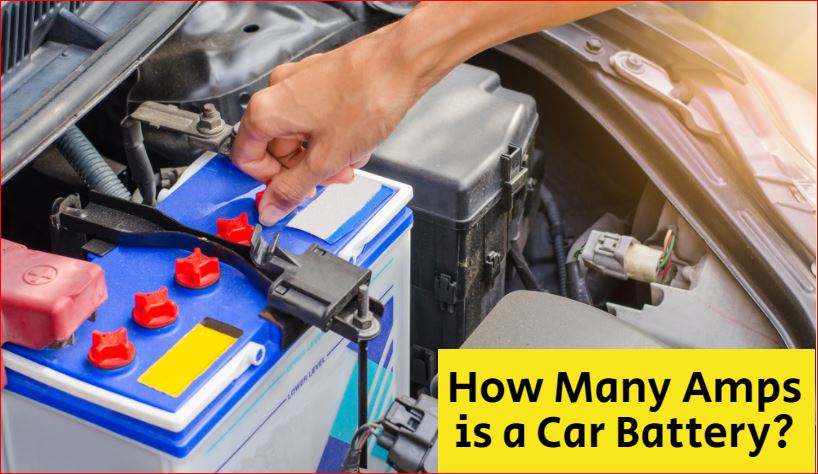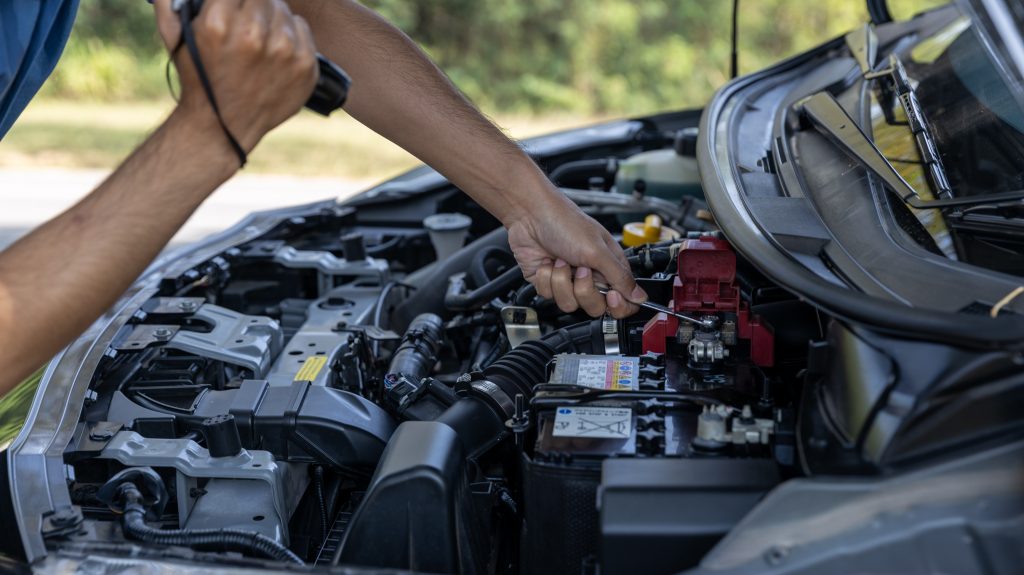A standard car battery has a capacity of about 45 to 100 amps per hour. Car batteries typically deliver a 400 to 600 amps current during a cold crank.
Understanding the amperage of a car battery is crucial for vehicle maintenance and troubleshooting. Car batteries are the unsung heroes of the automotive world, providing the essential current that brings your vehicle to life. These powerhouses store electrical energy, supply the necessary amps to start the engine, and power electrical components when the engine is off.
Knowing the amp capacity and output helps in selecting the correct battery for your car and ensures that the electrical system functions efficiently. Whether you’re a car enthusiast or just looking to keep your vehicle running smoothly, grasping the basics of car battery amps can save you time and money. As technology advances and demands on vehicle power increase, understanding your car battery’s capabilities becomes even more significant.
Introduction To Car Battery Capacity
Understanding the capacity of a car battery is crucial for vehicle performance. This capacity is often measured in amps. It tells you how much electrical charge the battery can deliver at a given moment. Car owners need to know this to ensure their vehicle runs smoothly.
The Role Of Amps In Car Batteries
Car batteries provide the necessary power to start an engine. The amps reflect the battery’s ability to supply this power. More amps mean the battery can handle more demanding electrical needs. A battery with higher amps can start a car more easily, especially in cold weather.
Measuring Electrical Charge In Auto Power
Batteries use amps to measure their electrical charge. This measurement helps to understand a battery’s capacity to power a car. When you measure a battery, you often see amps listed as CCA (Cold Cranking Amps) and AH (Ampere-Hours). CCA indicates the battery’s ability to start a car in cold temperatures. AH measures how long the battery can provide power.
- CCA: Important for cold-weather performance.
- AH: Tells you the battery’s life on a full charge.
Knowing these measurements helps you choose the correct battery for your car.
How Many Amps on a Car Battery?
A typical car battery operates at a nominal 12 volts, but when it comes to amperage, it varies widely depending on the vehicle’s requirements and the battery’s design. A standard car battery capacity is measured in ampere-hours (Ah), generally ranging between 40 to 120 Ah for most passenger vehicles. However, when it comes to cranking amps (CA) or cold cranking amps (CCA), which represent the battery’s ability to start the engine, the values are much higher. CCA values can range from about 300 to over 1000 amps, depending on the battery and the vehicle’s engine size. CCA is critical for ensuring the engine starts properly, especially in cold weather when engine oil is thicker and harder to move.

Credit: haynes.com
Peeking Under The Hood
Understanding your car battery is crucial for vehicle maintenance. A car battery’s amps tell a story of power and performance. Let’s lift the hood and decode what those numbers mean for your car’s electrical system.
Typical Car Battery Specifications
Car batteries come with specific details that define their capacity and output. These specs are vital for ensuring your vehicle gets the proper energy supply.
| Specification | Description |
|---|---|
| Voltage | Most cars use a 12-volt battery. |
| Ampere-hours (Ah) | Indicates the battery’s capacity to supply current. |
| Cold Cranking Amps (CCA) | Power the battery provides to start a car in cold weather. |
| Reserve Capacity (RC) | The time a battery runs essential accessories if the alternator fails. |
Understanding Amperage Demands
Ampere, or amp, measures how much electricity flows from the battery to the car. Different cars need different amps to start and run smoothly.
- A standard car battery typically offers between 400 to 600 amps.
- High-performance vehicles may require more amps for optimal function.
- Electronic accessories increase the amperage demand on the battery.
Check your vehicle’s manual for the recommended battery specifications. Match the ampere needs to avoid power issues.
The Amp Hour Rating Explained
Understanding the amp hour rating of a car battery is vital to knowing how long it can run before needing a recharge. This rating gives you a glimpse into the battery’s capacity, helping you make informed decisions for your vehicle’s power needs.
Calculating Amp Hours
Amp-hours (Ah) measure a battery’s electric charge capacity. To calculate this, multiply the current (amps) by the time (hours) the battery can deliver that current. For example, a battery that provides 5 amps for 20 hours has a 100 Ah capacity.
| Current (Amps) | Time (Hours) | Amp Hours (Ah) |
|---|---|---|
| 5 | 20 | 100 |
A higher Ah rating means more extended use before recharging. Remember, car batteries need to match your vehicle’s demands.
Comparing Battery Sizes And Capacities
Different vehicles require different batteries. Size and capacity vary, affecting how they power your car’s electrical systems.
- Small Cars – Smaller batteries, lower Ah ratings.
- Oversized Vehicles – Larger batteries, higher Ah ratings.
Always check the owner’s manual to find your car’s right battery size and capacity. A mismatch can lead to power issues or damage.
Choose a battery with the correct Ah rating for optimum performance and reliability. This ensures your car is ready to go whenever you are.

Credit: www.electronicshub.org
Cold Cranking Amps (CCA) Demystified
Cold Cranking Amps (CCA) Demystified helps us understand a car battery’s power in cold weather.
Importance Of CCA in Vehicle Batteries
CCA is crucial for starting your car in cold weather. It measures the battery’s ability to start an engine in freezing conditions.
- Higher CCA values mean better performance in freezing temperatures.
- Batteries with high CCA work well in places with cold winters.
How CCA Affects Performance
CCA directly influences how well your car starts on a cold day.
Here are the effects:
| CCA Rating | Effect on Performance |
|---|---|
| High CCA | Quick and reliable starts in cold weather |
| Low CCA | May struggle to start in cold temperatures |
Choose a battery with a CCA rating suitable for your climate to ensure the best performance.
Reserve Capacity (RC) And Its Significance
Understanding the Reserve Capacity (RC) of a car battery is crucial for vehicle reliability. RC indicates how long a battery can power a car’s essentials if the alternator fails. This measure tells us the number of minutes a fully charged battery at 80°F will discharge 25 amps until the battery drops below 10.5 volts. A higher RC value means more buffer time during unexpected situations, ensuring that vital car functions remain operational longer.
RC’s Impact On Car Battery Endurance
A car battery with a high RC rating offers prolonged endurance. This ensures your vehicle’s electrical systems stay active, even when the engine is off. For example, you can listen to the radio or use the lights without the engine running for a more extended period.
- Longer lasting: Batteries with high RC sustain critical car functions longer during alternator failure.
- Peace of mind: Assures that the vehicle can withstand more extended periods without engine power.
- Extended support: Powers essential safety features like hazard lights for extended periods.
Assessing RC for Emergency Situations
In emergencies, knowing your car battery’s RC can be a lifesaver. It allows you to manage power usage when the engine won’t start. Assessing RC helps you understand how long you can use electronics without draining the battery completely. This is especially important in cold weather when battery performance typically drops.
| RC Range | Usage Duration |
|---|---|
| 90-120 minutes | Longer emergency support |
| 60-89 minutes | Moderate emergency support |
| Less than 60 minutes | Limited emergency support |
Always check your RC: Make it a habit to know your car’s RC rating. This information is often found on the battery label or the vehicle’s manual. A higher RC means more time for lights and communication devices to operate in an emergency.
Remember, a strong RC rating is your ally on the road. It provides the confidence you need to handle unforeseen situations with ease. Choose a good RC-rating battery to ensure safety and comfort during travels and emergencies.

Testing And Maintenance For Optimal Amperage
Maintaining the proper amperage in your car battery is crucial for reliable performance. Regular testing and maintenance can help prevent unexpected breakdowns and extend your battery’s life. Let’s explore how to keep your car battery in top condition.
Routine Checks To Ensure Amperage Health
Regularly checking your car battery’s amperage is critical to avoiding power issues. A healthy car battery should typically have a charge close to its rated capacity. This is around 12.6 volts for most cars when fully charged and with the engine off. Below are steps to maintain battery health:
- Inspect battery terminals for corrosion.
- Clean terminals with a brush if needed.
- Ensure the battery is securely mounted.
- Check the electrolyte level, if applicable.
- Test the battery charge every six months.
Tools And Techniques For Battery Testing
For accurate testing, you need the right tools. A multimeter is a go-to instrument to measure your battery’s voltage. To test your battery, follow these instructions:
- Turn off your vehicle.
- Connect the multimeter’s red lead to the positive terminal.
- Connect the negative terminal to the black lead.
- Read the multimeter display; a healthy battery should read around 12.6 volts.
Load testers provide a more comprehensive battery health indication. They measure voltage under load, similar to when starting a car. This is how a load tester is used:
- Connect the tester to your battery.
- To apply a load, adhere to the manufacturer’s instructions.
- Watch for a voltage drop; it should not drop below 9.6 volts.
Remember, consistent care and timely testing will keep your car battery running smoothly. Remember these tips, and your car will thank you with unwavering service.
When To Replace: Signs Of A Failing Battery
Knowing when to replace a car battery is crucial for car health. A failing battery can lead to unexpected breakdowns.
Assessing Battery Age And Performance
An automobile battery’s typical lifespan is three to five years. Check your battery’s purchase date to gauge its age. If it’s near this range, test its performance.
Use a voltmeter to measure the battery’s voltage. A reading below 12.4 volts suggests poor health.
Symptoms Of Reduced Amperage
- Slow engine crank: The car takes longer to start.
- Dim lights: Headlights and dashboard lights are weaker.
- Electrical issues: Frequent electrical malfunctions.
- Warning light: The battery or check engine light appears.
These symptoms mean the battery’s amperage is declining. This affects overall performance and reliability.

Credit: www.jdpower.com
Choosing The Right Battery For Your Car
Every car needs a battery that matches its power requirements. Knowing the amps your car battery should have is crucial. This ensures smooth starts and consistent performance. Let’s dive into how to select the perfect battery for your vehicle.
Balancing Amps With Vehicle Requirements
Understand your car’s needs before buying a battery. The owner’s manual states the required amps. Don’t guess, or you might have chosen something wrong. A mismatch may cause harm or subpar performance.
- Check the Cold Cranking Amps (CCA): This shows how well the battery starts in cold weather.
- Consider the Reserve Capacity (RC): It indicates how long a battery can run on its power.
Match these specs with your car’s requirements to find the right balance.
Navigating The Market For The Best Fit
With numerous options available, finding the correct battery can be challenging. Use these tips to navigate the market.
- Read reviews: Other drivers’ experiences can guide you.
- Compare warranties: A more extended warranty often means better quality.
- Look for reliable brands: Choose companies known for quality.
These steps help you find a battery that fits your car perfectly.
Advanced Technologies In Car Batteries
Car batteries have taken giant leaps forward. New technologies boost performance and reliability. Let’s explore the latest in battery innovation.
Innovations In Battery Amperage And Efficiency
Modern car batteries are more than just power sources. They are marvels of engineering excellence. With advanced materials and design, they offer higher amperage and improved efficiency. This ensures your car has the power it needs whenever it needs it.
- Lithium-ion technology: Offers high energy density and lighter weight
- AGM (Absorbent Glass Mat): Better power delivery and longer life
- Enhanced Flooded Batteries (EFB): Superior start-stop performance
These technologies mean car batteries can handle more charge cycles. They also provide consistent power output over time.
The Future Of Automotive Power
The future shines bright for car battery tech. Research points to even more incredible leaps in the years ahead.
Solid-state batteries are on the horizon. They promise to revolutionize how we think about car power. With no liquid electrolytes, they are safer and have higher energy capacity.
Expect battery management systems to become more innovative. They will optimize battery life and performance like never before.
Here’s a glance at what’s coming:
| Technology | Benefits |
|---|---|
| Solid-State Batteries | Increased safety, longer lifespan |
| Smart BMS | Enhanced efficiency, adaptive charging |
Car batteries are set to become more powerful, efficient, and eco-friendly. This is good news for drivers everywhere.
Faqs On Car Battery Amperage
Understanding car battery amperage is crucial for vehicle maintenance. This section answers common questions and provides expert tips for keeping your car battery in top condition.
Top Questions Answered
Car owners often ask about battery amperage. This critical information helps select the correct battery and ensure proper vehicle function.
- What is battery amperage? Measured in amps, it indicates electric current flow.
- How many amps does a car battery have? A standard car battery offers about 48 amps.
- What’s the importance of amperage? It powers the starter and electronics.
- Does higher amperage mean a better battery? Not always. Match amperage to your car’s needs.
Expert Tips For Battery Care
Proper care extends battery life. Follow these expert tips for optimal performance.
- Regularly check the battery charge. Use a voltmeter for accurate readings.
- Clean battery terminals. Remove corrosion to ensure a good connection.
- Keep the battery secure. Prevent vibrations that can damage it.
- Avoid short trips. They keep the battery from charging all the way through.
Recall that the secret to a dependable automobile is a well-maintained battery. Refer to your vehicle manual for specific battery care instructions.

Frequently Asked Questions
How Many Amps Are In A 12v Car Battery?
A typical 12V car battery holds about 45 to 100 amp-hours, with cranking amps ranging from 400 to 1000A for starting the engine.
Is A Car Battery 2 Amp Or 10 Amp?
Car batteries are not rated in amps but measured in ampere-hours (Ah). Standard car batteries range from 40 to 120 Ah, indicating their capacity. Chargers may offer settings like 2 or 10 amps for slow or fast charging.
How Many Amps Should A Car Battery Draw?
When the vehicle is off, a healthy car battery should typically draw between 50 and 85 milliamps (0. 05-0. 085 amps).
How Do I Check The Amps On My Car Battery?
Use a multimeter set to the amperage setting to check the amps on your car battery. Connect the multimeter to the battery terminals while the car is off. Observe the reading for a precise measurement of current flow.
Conclusion
Understanding your car battery’s amperage is crucial for maintaining vehicle health and ensuring reliability. Always check the specific requirements of your vehicle and consult with a professional if unsure. Keeping this knowledge in hand will enhance your car’s performance and extend its battery life, saving you from unexpected troubles.

